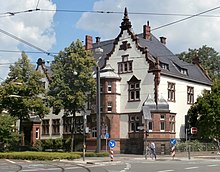Graurheindorfer Strasse 90
The building Graurheindorferstraße 90 is a residential building in Bonn district of Bonn-Castell , which from 1903 to 1907 as an officers' mess was built. It is located on the corner of Graurheindorfer Straße / Augustusring, a turn on the tram route to Auerberg , opposite the parish church of St. Joseph . The building stands as a monument under monument protection .
history
The officers' mess was part of the newly built barracks of the 7th Hussar Regiment , which was located north of Graurheindorfer Strasse. The drafting according to a sketch of the ministerial building department in the Prussian War Ministry as well as the local construction management were in the hands of the Bonn government master builder. D. Julius Rolffs . It was his first assignment after moving to Bonn.
After the dissolution of the regiments at the end of the German Empire (1918), the building housed the officers' mess of the French occupation troops and later part of the local police school , for which a new building was built next to it in 1927. From 1936 it was used by the Wehrmacht as an officer's home. After Bonn became the seat of government of the Federal Republic of Germany in 1949 , the site of the former hussar barracks and the neighboring Düppel barracks was a focal point for the establishment of federal ministries . The former officers' casino was also temporarily used as an office building by the local ministries. Later, part of the house housed private companies, while the remaining rooms housed apartments. In 1999 it was still in the possession of the Federal Property Office .
From 2004 to 2008 the building was extensively renovated and divided into eight apartments while retaining the former dining rooms of the officers' mess. Today an art gallery is operated in the basement .
architecture
The building has two to three storeys in brickwork and has a slate roof and a stepped gable . Stylistically it can be assigned to the German Neo-Renaissance . The facade is partly clad with stone cladding and partly plastered ( Terranova plaster ). The decorative forms include a portrayal of putti and the coat of arms of the hussar regiment in the stepped gable . The original floor area of the new building was 536 m².
Since 1908 the gable decoration of the former electoral stables (built around 1745–47) on today's Friedensplatz has been in the garden of the building .
Web links
References and comments
- ^ Until 1978 Rheindorfer Straße ( Graurheindorfer Straße in the Bonn street cadastre )
- ↑ List of monuments of the city of Bonn (as of March 15, 2019), p. 22, number A 987
- ↑ a b Zeitschrift für Bauwesen , 63rd year 1913, issue 10–12, supplement statistical evidence , p. 5.
- ↑ Horst-Pierre Bothien: Bonn sur-le-Rhin Occupation 1918-1926 (= City Museum Bonn : Forum History ., No. 14). morisel Verlag, Munich 2018, ISBN 978-3-943915-34-1 , p. 80.
- ↑ Association of reservists from the German Bundeswehr e. V., reservist comradeship Bonn-Mitte (ed.): Barracks in Bonn .
- ↑ A grandson looking for clues. The villas of the Bonn government architect Julius Rolffs . In: General-Anzeiger of September 5, 1997, p. 7.
- ^ Application , Bonn Council Information System
- ^ Courtly representation and ecclesiastical commissioning of the Wittelsbach archbishops in the Electorate of Cologne in the 18th century - plate volume (= Georg Satzinger (Ed.): Tholos - Kunsthistorische Studien , Volume 10.5). Rhema-Verlag, Münster 2019, ISBN 978-3-86887-034-3 , plates 205-207.
Coordinates: 50 ° 44 '48.9 " N , 7 ° 5' 42.2" E


